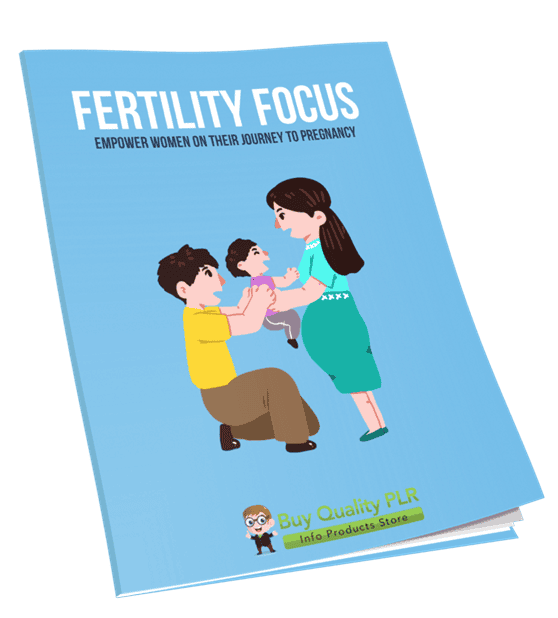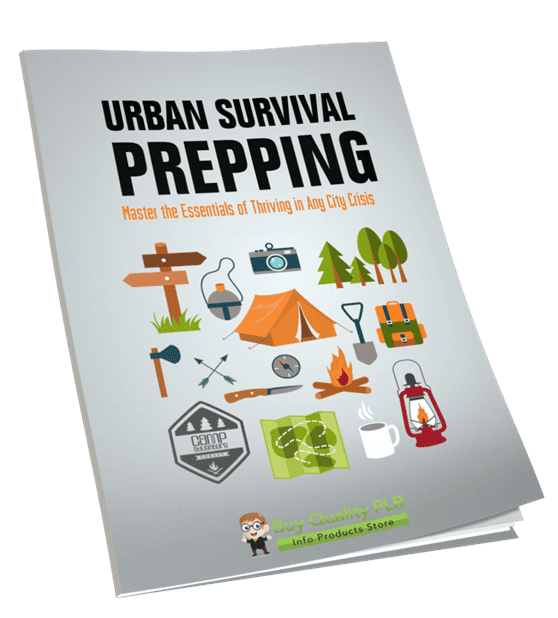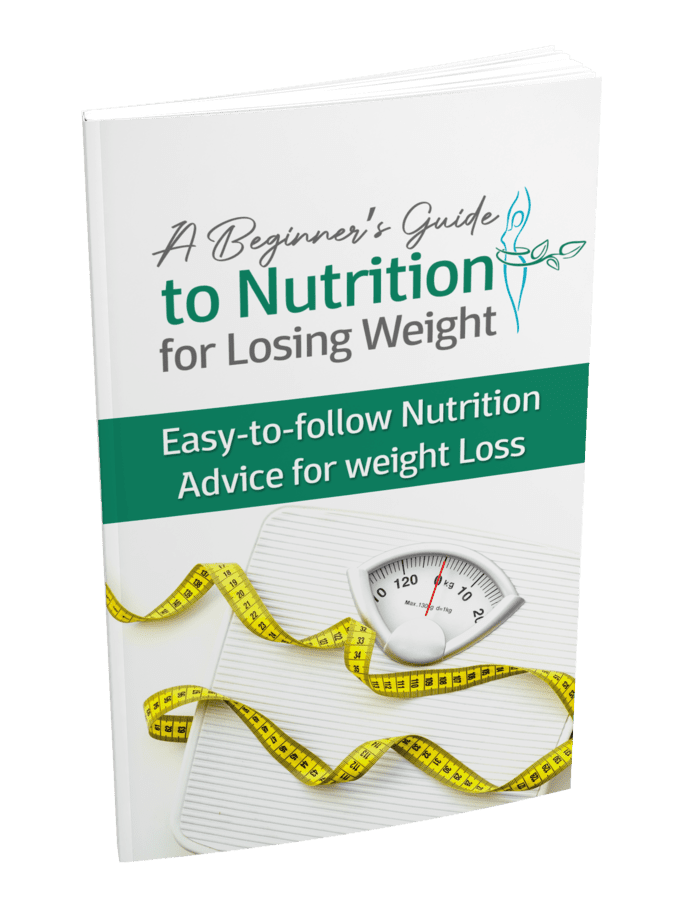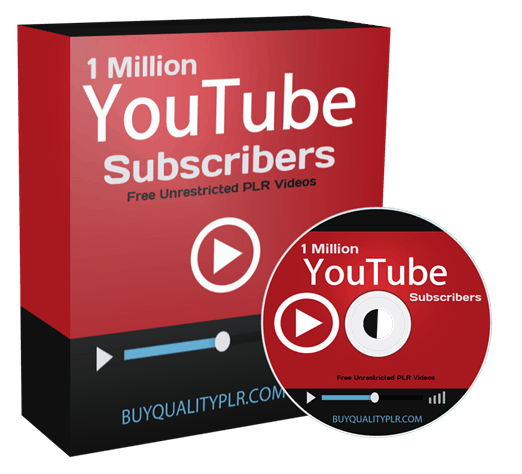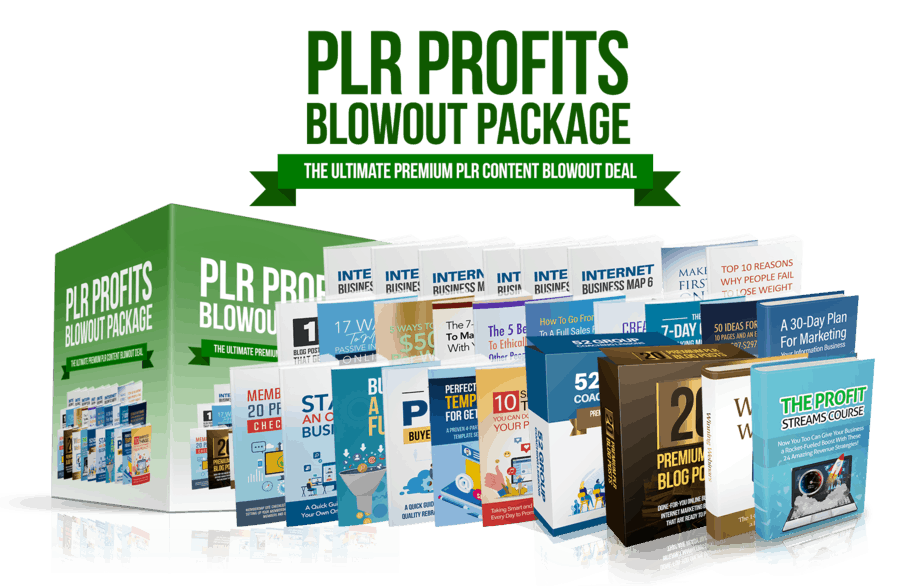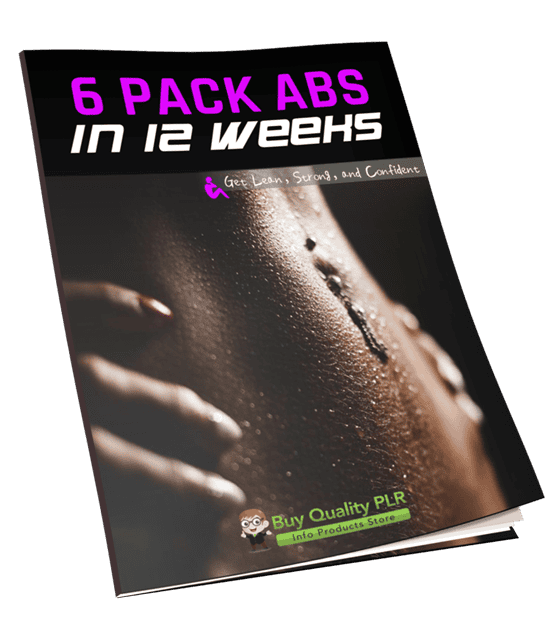
6 Pack Abs In 12 Weeks PLR Course 23k Words
in Fitness Mindset PLR , Fitness PLR , Fitness PLR Ebooks , PLR Checklists , PLR eBooks , PLR eCourses , PLR List Building Reports , Premium PLR , Premium PLR Emails , Premium PLR Reports , Premium White Label Brandable PLR Coaching Courses , Private Label Rights Products , Workout PLR , Workout PLR EbooksChoose Your Desired Option(s)
has been added to your cart!
have been added to your cart!
#fitnessmarketing #6packabs #workoutplan #healthandwellness #plrcourse #bodytransformation #digitalproducts #fitnessgoals
Help Your Customers Get Lean, Strong, and Confident — While You Build a Profitable Fitness Brand
Everyone dreams of having a toned, flat stomach and defined abs — but few know how to actually get there without wasting time on random exercises or fad diets.
The 6 Pack Abs in 12 Weeks PLR Course gives you a professionally written, fully structured fitness program that delivers real, sustainable results in just 3 months. It’s simple, science-backed, and adaptable for any fitness level.
Even better? It’s PLR content, which means you can sell it as your own, rebrand it, use it for your coaching business, or turn it into an online course — without spending months creating it yourself.
This comprehensive 5-module system combines nutrition, exercise, mindset, and maintenance so your audience not only gets abs but keeps them long-term.
Presenting…
6 Pack Abs In 12 Weeks PLR Course 23k Words
Why This Course Is a Must-Have PLR Product
✅ High-Demand Niche: Fitness and body transformation are evergreen — and “6 pack abs” is one of the most searched fitness topics worldwide.
✅ Results-Driven Structure: 12-week framework ensures measurable progress.
✅ Fully Customizable: Add your brand voice, workouts, or bonus guides.
✅ Perfect for Fitness Coaches, YouTubers, and Online Trainers: Save time creating your next fitness course or challenge.
✅ Proven to Sell: Programs promising visible transformations (like abs) consistently outperform generic fitness guides.
What This Course Covers
The 6 Pack Abs in 12 Weeks Course takes readers step by step through mindset, workouts, nutrition, and lifestyle adjustments — designed for visible, lasting results.
Module 1: Foundation First – Build the Base for Abs
Set the groundwork for fat loss and muscle definition.
- Step 1: Understand Your Core
Teaches the science behind core muscles — abs, obliques, lower back — and their importance in posture and strength. - Step 2: Clean Up Your Diet
Easy-to-follow guide to cut processed foods and sugars while boosting clean, whole-food eating. - Step 3: Create Your Calorie Blueprint
Shows how to calculate caloric intake to lose fat without losing energy. - Step 4: Set SMART Fitness Goals
Helps learners set realistic, measurable goals for the 12-week journey.
Outcome: A clear plan and a strong foundation — mentally and physically — to begin transforming the body.
Module 2: Burn Fat, Not Muscle – The Cardio & HIIT Kickoff
Torch fat fast while maintaining lean muscle.
- Step 1: Start Steady-State Cardio
Beginner-friendly cardio plan to boost metabolism and kickstart fat burn. - Step 2: Add HIIT Workouts
Introduces high-intensity training to maximize results in minimum time. - Step 3: Track Progress Weekly
A tracking system to measure progress through weight, waistline, and fitness markers. - Step 4: Rest & Recovery
Educates learners on sleep, recovery, and rest days to prevent burnout.
Outcome: Fat starts melting away while stamina, endurance, and focus improve.
Module 3: Sculpt & Strengthen – Target Your Core the Right Way
Train smarter, not harder. Build visible abs efficiently.
- Step 1: Master the Basics (Planks, Crunches, Leg Raises)
Step-by-step form breakdowns for classic core exercises that deliver results. - Step 2: Follow a 3-Day Core Routine
Structured plan alternating upper, lower, and oblique focus days. - Step 3: Mix Bodyweight and Weighted Ab Exercises
Introduces progressive overload to speed up muscle definition. - Step 4: Focus on Mind-Muscle Connection
Teaches how to engage the core correctly for maximum contraction and safety.
Outcome: A well-rounded core routine that stimulates all abdominal regions and improves posture and strength.
Module 4: Eat for the Abs – Dial In Your Nutrition
Unlock the secret to visible abs: eating smart.
- Step 1: Prioritize Protein in Every Meal
Teaches why protein is crucial for muscle retention and fat burning. - Step 2: Plan Your Meals Around Whole Foods
Encourages clean eating and simple meal prepping strategies. - Step 3: Time Your Meals for Energy & Recovery
Explains nutrient timing, post-workout meals, and energy balance. - Step 4: Stay Hydrated Like a Pro
Covers hydration targets, electrolyte balance, and practical tips.
Outcome: A sustainable, satisfying eating plan that accelerates results.
Module 5: The Final Push – Peak Phase & Maintenance
Finish strong and maintain your results for life.
- Step 1: Advanced Abs Routine
Introduces new moves like hanging leg raises, ab wheel rollouts, and stability ball exercises. - Step 2: Fine-Tune Your Diet with a Mini Cut
Teaches a short-term “shred” strategy to get photo-ready abs. - Step 3: Celebrate Visible Changes with Progress Pics
Encourages tracking physical changes and celebrating milestones. - Step 4: Create a Maintenance Plan
Provides a post-12-week plan to keep abs visible year-round.
Outcome: A complete, repeatable system that leads to visible abs and lifelong fitness habits.
What’s Included in the Package
- 🧩 21,670-Word Course: 5 detailed modules with 20 step-by-step lessons.
- 📋 6 Pack Abs in 12 Weeks Checklist (634 Words): Summarizes core action steps for fast reference.
- 💬 FAQs (718 Words): Prewritten answers to common fitness and nutrition questions.
- 🏆 Ready-Made Sales Page (625 Words): Upload-ready copy that converts visitors into buyers.
- ⚙️ Full Private Label Rights License: Edit, brand, sell, and profit.
Ways to Use and Profit From This PLR Course
- Sell as a Fitness Course – Add your brand, upload to your site, and charge $47–$197 per copy.
- Convert to a Video Training Program – Record voiceovers or workouts for a $297+ premium offer.
- Bundle with Other PLR Fitness Products – Combine with nutrition or workout guides to create a “Complete Transformation System.”
- Launch a 12-Week Fitness Challenge – Drip each module weekly and charge for access or coaching support.
- Offer as a Lead Magnet Funnel – Give away the first module to capture leads and upsell the full course.
- Start a Fitness Membership Site – Add this course as a featured program to generate monthly recurring revenue.
- Create an Ebook or Printable Guide – Reformat into a downloadable fitness book for Amazon KDP or Etsy.
- Turn It into a Podcast or YouTube Series – Use each step as an episode script to grow an audience.
- Use It for Coaching Clients – Save time with a prebuilt system for 1:1 or group coaching.
- Flip It for Profit – Rebrand and sell as a done-for-you fitness website or course business.
Perfect For
- Fitness Coaches and Personal Trainers
- YouTube Fitness Influencers
- Health Bloggers and Lifestyle Entrepreneurs
- Wellness Coaches and Nutritionists
- Online Course Creators in the Fitness Niche
- Digital Product Sellers Looking for Evergreen Niches
License Terms
You CAN:
✅ Edit, rebrand, and sell this product as your own.
✅ Convert into video, audio, print, or membership content.
✅ Use excerpts for blog posts, lead magnets, or email newsletters.
✅ Bundle with other paid fitness or PLR products.
You CANNOT:
❌ Pass PLR, resale, or giveaway rights to customers.
❌ Give away the entire product in its original form for free.
❌ Offer 100% affiliate commissions (max 75%).
❌ Add it to an already-purchased membership without an extra charge.
Why This PLR Course Sells
- Evergreen Topic: “6 Pack Abs” will always attract fitness buyers.
- Actionable Results: 12-week timeline guarantees visible progress.
- Comprehensive Plan: Combines fitness, nutrition, and lifestyle changes.
- Plug-and-Play Content: Everything’s done for you — just rebrand and sell.
- Authority Builder: Position yourself as a credible fitness expert overnight.
Start Selling Transformation
With the 6 Pack Abs in 12 Weeks PLR Course, you’re not just selling fitness content — you’re offering transformation, confidence, and motivation.
And with PLR rights, you keep 100% of the profits.
What You’ll Receive Today:
✅ 21,670-Word Fitness Course
✅ 634-Word Checklist
✅ 718-Word FAQ Guide
✅ 625-Word Ready-to-Use Sales Page
✅ Full PLR License
Empower your audience to build visible, lasting abs — and build a profitable fitness business while you’re at it.
🔥 Get Instant Access to the 6 Pack Abs in 12 Weeks PLR Course Now!
has been added to your cart!
have been added to your cart!
Here A Sample of the 6 Pack Abs In 12 Weeks PLR Course
Module 1: Foundation First – Build the Base for Abs
Let’s start from the core (literally!). Before the abs start to show, you need to lay the right foundation.
Step 1: Understand Your Core
Course Objective for This Step:
By the end of this lesson, learners will have a clear understanding of the core muscle group, how it functions, and why it plays a critical role in achieving visible six-pack abs and overall body strength. This foundational knowledge prepares learners for the physical training ahead by ensuring they know what they’re targeting and why.
Step-by-Step Training Instructions and Description:
1. Definition: What is the Core?
Most people think the core is just the six-pack muscles (rectus abdominis). While that’s a part of it, the core is actually an entire group of muscles that work together to support your spine, stabilize your body, and power your movement.
The core includes:
- Rectus Abdominis: This is the front part most people call the “six-pack”.
- Transversus Abdominis: The deepest abdominal muscle, wrapping around the spine like a corset.
- Internal and External Obliques: Located on the sides of the torso, these control twisting and side bending.
- Erector Spinae: A group of muscles running along the spine that supports posture and spinal extension.
- Pelvic Floor Muscles: Often overlooked, these support lower abdominal function and core stability.
- Diaphragm: Plays a key role in breathing and intra-abdominal pressure.
- Multifidus and Quadratus Lumborum (Lower Back Muscles): Help stabilize the spine during movement.
- Gluteal Muscles (Glutes): Though part of the lower body, your glutes contribute heavily to core strength and stability.
Conclusion:
Your core is a 360-degree muscular system that includes your front, back, and sides — from your shoulders to your hips.
2. Why the Core Matters for More Than Just Abs
Before training a muscle, you need to understand its purpose. The core doesn’t just help you look good—it plays a critical functional role in almost every movement your body makes.
Key Functions of the Core:
- Stability: The core acts like a stabilizing center for your entire body. It keeps your spine supported during movement and prevents injury during lifting, twisting, and even standing.
- Balance and Posture: A strong core helps you maintain an upright posture and avoid back pain. It’s crucial for athletes, office workers, and older adults alike.
- Movement Efficiency: Every time you walk, lift a bag, stand from a chair, or swing your arms, your core muscles are engaged. A weak core reduces your performance and puts other joints under strain.
- Protecting the Lower Back: One of the most important functions of the core is to protect your lumbar spine. Strong core muscles take pressure off your lower back, preventing chronic pain and injury.
3. Learn the Muscle Map (with Visual Aids or Diagrams)
Teaching Tip for Course Creators:
Include anatomical illustrations of the core. Use arrows, labels, and overlays to show how each part of the body contributes to core function. Use universally recognized anatomical terms for international learners.
Suggested visuals:
- A front-view diagram showing the rectus abdominis, obliques, and transversus abdominis.
- A side-view illustration showing the spine, multifidus, and erector spinae.
- A top-down pelvic view showing the pelvic floor and diaphragm.
- Use clear fonts and consistent symbols (e.g., arrows, lines) that are not language-specific.
Multilingual accessibility tip: Provide visual descriptions or closed captions to assist international learners with varying levels of English proficiency.
4. Apply It: Real-Life Movements That Use the Core
Learners should now connect the concept of “the core” to everyday movement and fitness.
Examples:
- Standing Tall: Your core holds your torso upright. If your core is weak, your shoulders round, and your back slouches.
- Doing a Sit-Up: It’s not just the abs pulling you up. Your hip flexors, obliques, and stabilizers are working together.
- Lifting Objects: From picking up a suitcase to lifting a barbell, your core braces the spine and transfers power.
- Twisting or Rotating: Whether turning to grab something from the backseat or swinging a tennis racquet, obliques and spinal rotators do the work.
- Breathing Properly: A functional core coordinates with your diaphragm. Shallow breathing limits performance and tightens muscles unnecessarily.
Instructor Tip:
Ask students to practice identifying when they use their core throughout their daily routine. This could be a journal prompt or quick in-course exercise.
Conclusion & Key Takeaway
Understanding your core is not optional if you want six-pack abs. It’s the critical first step. When you train your core intelligently—not just your abs—you build a strong, functional foundation. This allows for safe fat loss, improved strength, better posture, and the muscle definition you want to see by Week 12.
Remember this:
Strong core = visible abs + functional body.
Step 2: Clean Up Your Diet
Module 1 – Foundation First: Build the Base for Abs
Lesson Title: “Fuel That Reveals the Six-Pack”
Lesson Objective
By the end of this lesson learners will be able to:
- Identify hidden sugars, junk foods and refined carbohydrates in their daily meals.
- Implement at least three food “swaps” that reduce empty calories while preserving taste and satisfaction.
- Set a personalised hydration target (litres ∙ day⁻¹) and a simple system for tracking water intake.
- Build a one-day sample menu that meets their calorie goals and macro needs with whole-food ingredients.
Instructor Preparation Checklist
| ✓ / ✗ | Task |
| ✓ | Provide an editable food-diary template (metric & imperial columns). |
| ✓ | Prepare before/after food-swap slides (e.g., soda → sparkling water + citrus). |
| ✓ | Print or embed international nutrition-label examples (EU, US, AUS, ASEAN). |
| ✓ | Have a hydration calculator (35 mL ∙ kg⁻¹ body-weight baseline) ready for class demo. |
| ✓ | Offer a sample grocery list with whole-food staples available worldwide. |
Step-by-Step Training Instructions & Descriptions
Teaching tip: Present each numbered action live, then pause for learners to complete the matching workbook exercise. Use symbols such as → for recommended moves and ✗ for habits to eliminate.
1. Audit, Don’t Guess
- Record every bite and sip for 48 h
- Learners write quantities, brand names and preparation methods.
- Emphasise honesty—no grades, just data.
- Highlight Added Sugars (✗)
- Show label terms: sucrose, HFCS, dextrose, jaggery, malt syrup, glucose-fructose.
- Flag Ultra-Processed Foods (✗)
- Packaged items with ≥ 5 ingredients or ingredients a home cook would not use (e.g., mono- and diglycerides).
- Circle Whole-Food Items (✓)
- Single-ingredient foods: oats, lentils, eggs, fresh produce, plain yoghurt.
Learners now hold a colour-coded “food x-ray” of their habits.
2. Simple Swaps Framework
| Current Choice (✗) | Better Choice (→) | Why It Works |
| 355 mL cola (39 g sugar) | 355 mL sparkling water + 30 mL fresh lime | Zero sugar, same fizz, added vitamin C |
| White bread (2 slices) | 100 g whole-grain rye | + fibre slows glucose spike |
| Potato chips (30 g) | 30 g roasted chickpeas | + protein, − sat fat |
| Flavoured yoghurt (150 g) | Plain Greek yoghurt (100 g) + 50 g berries | Cuts sugar, boosts protein & antioxidants |
Activity: Learners select three personal swaps and write a one-sentence “because” statement to lock in the rationale.
3. Refined Carbs → Whole Grains
- Identify staple refined carbs (white rice, pasta, white flour tortillas).
- Choose global whole-grain counterparts:
- Brown rice (widely available).
- Quinoa (South America origin, stocked in most regions).
- Millet or sorghum (Africa/Asia).
- Whole-wheat couscous (Middle East, North Africa).
- Portion Guide: Use the Plate Method
- ½ plate non-starchy vegetables.
- ¼ plate lean protein.
- ¼ plate whole grains or legumes.
International visuals remove language barriers.
4. Hydration Protocol
- Calculate baseline: body-weight (kg) × 35 mL → daily target (L).
- Example: 70 kg × 35 mL = 2 .45 L ≈ 2 ½ L.
- Add 500 mL for each 30 min intense workout.
- Tracking systems:
- Reusable bottle with volume markers.
- App reminders in learner’s local language.
- Colour Check: Urine should be pale straw—a universal sign everyone can see.
5. Build a One-Day Clean Menu
| Meal | Example Foods | Macro Focus |
| Breakfast | Rolled oats (50 g dry) cooked in water, 1 boiled egg, 1 cup mixed berries | Complex carbs + protein |
| Snack | Apple (150 g) + 10 g peanut butter | Fibre + healthy fat |
| Lunch | Grilled chicken breast (120 g), quinoa salad (quinoa 80 g cooked, cucumbers, tomatoes, olive oil) | Lean protein + whole grains |
| Snack | Plain yoghurt (125 g) + cinnamon | Probiotic + low sugar |
| Dinner | Baked salmon (150 g), steamed broccoli (200 g), sweet potato (150 g) | Omega-3 + micronutrients |
| Fluids | ≥ 2 ½ L water spaced across the day | Hydration |
Task: Learners adapt the template using foods available and affordable in their region, maintaining the same macro balance.
6. Reading International Food Labels
- Locate the “per 100 g” line—this normalises units across countries.
- Sugar threshold: aim for ≤ 5 g free sugar ∙ 100 g⁻¹ (WHO guidance).
- Sodium limit: ≤ 400 mg ∙ 100 g⁻¹ for processed items.
- Trans-fat check: “0 g” or “not detected”; if label lists partially hydrogenated oils, avoid (✗).
- Ingredient order: first three items tell the story—if sugar appears early, rethink.
Provide side-by-side screenshots of EU traffic-light, US Nutrition Facts, and Australian HSR panels to familiarise global learners.
7. Monitor & Iterate
- Weekly Measurements:
- Waist circumference (cm / in).
- Body mass (kg / lb).
- Subjective energy score 1-10.
- Adjust Swaps: If weight stalls, remove another sugary item or reduce portion of starchy carbs at dinner.
- Celebrate Compliance, Not Perfection: Aim for 80 % clean choices—room for cultural treats keeps diet sustainable.
Conclusion & Key Takeaway
Cleaning up your diet is less about strict restriction and more about smart replacement. When learners master:
- Whole-food swaps
- Label literacy
- Consistent hydration
…they create the metabolic environment that lets abdominal training show. Encourage creators to revisit this lesson often; dietary habits make or break the 12-week six-pack promise.
Optional Resources for Course Creators
- Downloadable PDF workbook (food diary, swap chart, water tracker).
- Slides in PowerPoint & Google Slides formats with royalty-free images.
- Short demo videos showing global grocery aisles to illustrate real-world label reading.
Step 3: Create Your Calorie Blueprint
Module 1 – Foundation First: Build the Base for Abs
Lesson Title: “Your Personal Fat-Burning Equation”
Lesson Objective
By the end of this lesson, learners will be able to:
- Understand the importance of calorie control for fat loss and visible abs.
- Calculate their Total Daily Energy Expenditure (TDEE) using a globally relevant method.
- Set a sustainable calorie deficit tailored to their body type and goal.
- Begin tracking intake with accuracy using common tools and methods.
Instructor Prep Checklist
| ✓ / ✗ | Task |
| ✓ | Provide a downloadable Calorie Blueprint Worksheet with metric and imperial fields. |
| ✓ | Include a step-by-step calorie calculator link (Harris-Benedict or Mifflin-St Jeor preferred). |
| ✓ | Prepare activity level chart with visual icons for sedentary to very active. |
| ✓ | Offer case study examples of three learners: male/female, different countries, weights. |
| ✓ | Include macro balance overview for later reference (but keep focus on calories here). |
Step-by-Step Training Instructions & Descriptions
Teaching Tip: Reinforce that “abs are built in the gym, but revealed in the kitchen.” Without a calorie deficit, abdominal definition will remain hidden under stored body fat—no matter how strong the core muscles are.
1. Understand the Calorie Equation
To burn fat and reveal your abs, you must consistently burn more calories than you consume. This is known as a caloric deficit.
Think of it like a financial budget:
- Calories In = Income (food, drinks)
- Calories Out = Expenses (resting metabolism, exercise, daily activity)
If you spend more than you earn, you create a deficit. In fat loss, this “deficit” means your body starts tapping into fat stores for energy.
2. Calculate Your Baseline Metabolism (BMR)
BMR = Basal Metabolic Rate – the calories your body burns just to survive (breathing, circulation, brain function).
Use the Mifflin-St Jeor Formula (widely used, internationally accepted):
For men:
BMR = 10 × weight (kg) + 6.25 × height (cm) − 5 × age (y) + 5
For women:
BMR = 10 × weight (kg) + 6.25 × height (cm) − 5 × age (y) − 161
Example:
A 30-year-old woman, 65 kg, 165 cm
= 10×65 + 6.25×165 − 5×30 − 161
= 650 + 1031.25 − 150 − 161
BMR = 1,370 kcal/day
Instructor tip: Use an online calculator with this formula and allow learners to enter metric or imperial units.
3. Adjust for Daily Activity (TDEE)
TDEE = Total Daily Energy Expenditure
This factors in how active the learner is throughout the day:
| Activity Level | Multiplier | Description |
| Sedentary | BMR × 1.2 | Desk job, little or no exercise |
| Lightly Active | BMR × 1.375 | Light exercise/sports 1–3 days/week |
| Moderately Active | BMR × 1.55 | Moderate exercise 3–5 days/week |
| Very Active | BMR × 1.725 | Intense exercise 6–7 days/week |
| Extra Active | BMR × 1.9 | Physically demanding job, athlete |
Example Continued:
BMR = 1,370 kcal
Activity level = Moderately Active
TDEE = 1,370 × 1.55 = 2,123 kcal/day
This means she needs around 2,123 calories/day to maintain her current weight.
4. Set Your Fat-Loss Target (Caloric Deficit)
To lose body fat (especially from the abdomen), you must consume fewer calories than your TDEE. The size of your deficit affects how fast you lose weight and how sustainable your journey is.
Safe & Effective Deficit Guidelines:
| Goal | Deficit | Result |
| Mild fat loss | 10–15% | Gradual change, very sustainable |
| Moderate fat loss | 20% | Good for most learners |
| Aggressive (short-term only) | 25–30% | Fast results, harder to maintain |
Example Continued:
TDEE = 2,123 kcal
Moderate deficit (20%) = 2,123 × 0.20 = 425 kcal
Calorie Goal = 2,123 − 425 = ~1,700 kcal/day
5. Important Notes for Accuracy
- Never go below BMR. It’s unsafe and may slow your metabolism.
- Minimum intake:
- Women: 1,400–1,500 kcal/day (unless medically supervised)
- Men: 1,700–1,800 kcal/day
- Adjust for progress. Recalculate TDEE every 4–6 weeks or if your weight changes significantly.
6. Begin Tracking Intake
Learners can now use their calorie target to track actual food intake. Choose one of these methods:
Manual Tracking
- Use food labels + kitchen scale
- Great for awareness, especially in countries with limited app access
Digital Apps (Global)
| App | Available Regions | Strength |
| MyFitnessPal | Worldwide | Barcode scanning, large database |
| Cronometer | US, EU, AUS | Micronutrient tracking |
| Yazio | Europe, Asia | Culturally diverse food listings |
| Lose It! | US, CA, UK | Clean UI, easy to use |
Tip: Always track meals before eating, not after. Pre-tracking prevents overeating.
7. Activity: Build Your Calorie Blueprint
- Use the worksheet or calculator to find:
- BMR
- TDEE
- Target daily calories (TDEE − 20%)
- Choose your tracking method (manual or digital).
- Write out a “Calorie Goal Pledge”:
- “I will aim for ___ kcal/day to reduce fat and uncover my abs.”
- Decide when to re-check your calorie blueprint (e.g., every 30 days).
Conclusion & Key Takeaway
Creating your calorie blueprint is the first concrete step to controlling fat loss.
It’s not about starving or guessing—it’s about informed choices backed by math and biology.
When learners understand:
- How many calories they burn
- How to create a moderate, sustainable deficit
- How to track and stay within that range
…they unlock the secret to long-term fat loss and visible abdominal definition.
Optional Add-ons for International Course Creators
- Calorie Blueprint Worksheet (.docx, .pdf, .Google Sheet)
- Downloadable Calculator Embed Code for LMS platforms (Teachable, Kajabi, Moodle)
- Calorie Tracking App Comparison Guide (printable for international learners)
Step 4: Set SMART Fitness Goals
Module 1 – Foundation First: Build the Base for Abs
Lesson Title: “Turning Vision Into a Plan: SMART Goal Setting for a 12-Week Abs Transformation”
Lesson Objective
By the end of this step, learners will be able to:
- Understand the importance of goal-setting for fitness transformation
- Create specific, measurable, realistic goals for fat loss and core definition
- Break down their 12-week goal into short-term checkpoints
- Use tracking tools to measure progress over time
Instructor Prep Checklist
| ✓ / ✗ | Task |
| ✓ | Provide a downloadable SMART Goal Planner Template (metric and imperial units) |
| ✓ | Share examples of SMART vs vague goals in visual or text form |
| ✓ | Include goal-tracking chart or mobile app suggestions |
| ✓ | Prepare case studies with common obstacles and how learners adjusted their goals |
| ✓ | Ensure accessibility for learners from all regions, with culturally diverse examples |
Step-by-Step Training Instructions & Descriptions
Reminder for Learners: “Abs” is not a vague idea. It’s a result of measurable progress — lowering your body fat percentage, strengthening your core, and maintaining consistency. To succeed, your goals must be as focused as your workouts.
1. Why SMART Goals Matter
Many people begin their fitness journey saying things like:
- “I want to lose weight.”
- “I want to get toned.”
- “I want abs.”
While these are good starting motivations, they lack structure. Without clarity and measurability, motivation fades and progress stalls. That’s where SMART goals come in.
2. What Are SMART Goals?
The SMART method ensures your goals are Specific, Measurable, Achievable, Relevant, and Time-Bound.
| Letter | Meaning | Example (Fitness-Oriented) |
| S – Specific | Clear and detailed | “I want to drop 2 cm from my waistline.” |
| M – Measurable | Trackable with numbers or data | “I’ll track my waist every 2 weeks.” |
| A – Achievable | Realistic for your schedule and body type | “I’ll work out 4 days per week.” |
| R – Relevant | Matches your long-term goal | “This supports my goal of 6-pack abs.” |
| T – Time-Bound | Has a clear deadline | “By Week 4, I will reduce my waist by 2 cm.” |
Instructor Tip: Have learners write 2–3 SMART goals for the first 4 weeks using your template.
3. Set the 12-Week “Big Picture” Goal
Ask your learners to visualize their desired outcome 12 weeks from now. It needs to be more concrete than “have abs.”
Encourage them to write one primary outcome goal:
Examples:
- “Reduce body fat percentage from 24% to 18%.”
- “Drop 5 cm off my waist.”
- “Complete 3 sets of 20 hanging leg raises without rest.”
- “Fit into size ___ jeans or trousers comfortably.”
Note: Body changes vary per person. Remind learners that the appearance of abs depends on genetics, fat distribution, and effort — but steady results are always achievable with consistency.
4. Break It Down Into 4-Week Milestones
Once the 12-week goal is set, help learners break it down into three 4-week mini-targets. This keeps momentum high and offers regular checkpoints.
| Week | SMART Goal Example |
| Week 1–4 | Lose 1.5 cm off waistline and reduce sugar intake by 80% |
| Week 5–8 | Lower body fat by 2%, increase plank hold to 90 seconds |
| Week 9–12 | Drop 3 cm total from waist, complete 4 ab workouts per week |
Tracking Tip: Use a tape measure, scale (optional), photos, and fitness tests (e.g., how many controlled crunches in 1 minute).
5. Add Process Goals, Not Just Outcome Goals
Help your learners focus not only on “what they want to achieve,” but “what they will do to achieve it.”
These are process goals — daily and weekly habits that drive transformation.
Examples of Process Goals:
- “I will walk 8,000 steps a day, 6 days a week.”
- “I will drink 2.5 liters of water per day.”
- “I will prepare all weekday lunches at home for better calorie control.”
- “I will attend every Monday and Thursday ab workout class without fail.”
This teaches learners to stay committed to the process, even when visual changes take time.
6. Document the Starting Point
Before working toward any goal, learners must understand where they’re starting from.
Encourage documentation:
| What to Track | How |
| Waist measurement | Tape measure (above the navel) |
| Weight (optional) | Digital scale (first thing in the morning, weekly) |
| Front, side, and back photos | Same lighting, every 2 weeks |
| Core strength test | Max plank hold time, crunch reps in 1 minute |
This gives learners a benchmark to reflect on progress and feel proud of their commitment.
7. Stay Accountable: Use Tracking Tools
Encourage learners to keep a weekly log of their:
- Workouts completed
- Nutrition compliance (e.g., % within calorie range)
- Sleep and hydration habits
- Stress or mindset notes
Recommended Tools for International Learners:
| Tool | Type | Availability |
| Google Sheets | Digital tracking | Global |
| FitNotes | Workout logging app | Android |
| Strong | Strength log | iOS & Android |
| Habitica | Habit tracker with gamification | Global |
| Paper journal | Simple & flexible | Anywhere |
Make tracking a non-negotiable habit, not just an optional step.
8. Final Activity: Write and Share Your SMART Goal
Have learners write out one clear SMART goal and break it into 3 checkpoints. Use this structure:
- My 12-week SMART goal:
“By [date], I will [action/result] so that I can [personal motivation].” - My 4-week checkpoints:
- By Week 4, I will…
- By Week 8, I will…
- By Week 12, I will…
Encourage learners to keep this statement visible — in their phone, bathroom mirror, or journal — as a daily reminder.
Conclusion & Key Takeaway
Fitness without a goal is like setting off on a trip with no destination.
Your abs journey becomes significantly more powerful when it’s tied to clear, realistic, and personalized outcomes.
SMART goals remove the guesswork and give you structure.
They build motivation, guide daily action, and give you something to celebrate — every single week.
Optional Add-ons for International Course Creators
- SMART Goal Planner (Printable PDF + Editable Google Doc)
- Weekly Progress Tracker Template
- Goal-Setting Worksheets for Individuals, Groups, or Classes
- Sample “SMART Goal Coaching Session” Script for video delivery
- Slide Deck for this lesson (if teaching in-person or via video)
We’re also giving these extra bonuses
6 Pack Abs In 12 Weeks – Checklist
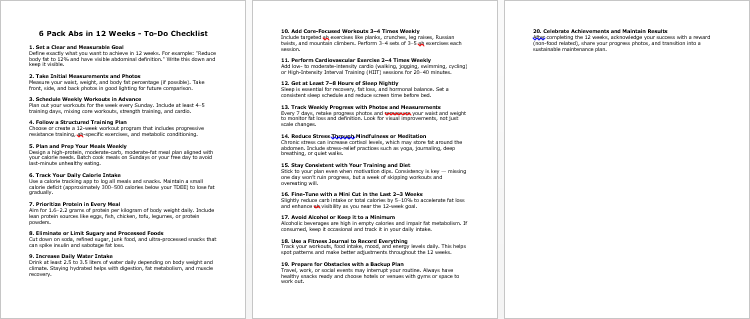
6 Pack Abs In 12 Weeks – FAQs

6 Pack Abs In 12 Weeks – Salespage Content
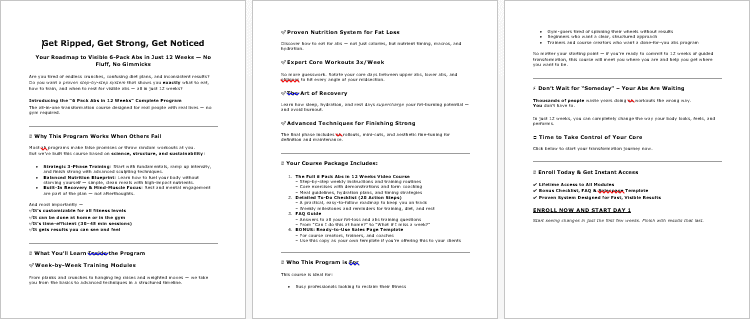
Package Details:
Word Count: 21 670 Words
Number of Pages: 112
6 Pack Abs In 12 Weeks – Bonus Content
Checklist
Word Count: 634 words
FAQs
Word Count: 718 words
Salespage Content
Word Count: 625 words
Total Word Count: 23 647 Words
Your PLR License Terms
PERMISSIONS: What Can You Do With These Materials?
Sell the content basically as it is (with some minor tweaks to make it “yours”).
If you are going to claim copyright to anything created with this content, then you must substantially change at 75% of the content to distinguish yourself from other licensees.
Break up the content into small portions to sell as individual reports for $10-$20 each.
Bundle the content with other existing content to create larger products for $47-$97 each.
Setup your own membership site with the content and generate monthly residual payments!
Take the content and convert it into a multiple-week “eclass” that you charge $297-$497 to access!
Use the content to create a “physical” product that you sell for premium prices!
Convert it to audios, videos, membership site content and more.
Excerpt and / or edit portions of the content to give away for free as blog posts, reports, etc. to use as lead magnets, incentives and more!
Create your own original product from it, set it up at a site and “flip” the site for megabucks!
RESTRICTIONS: What Can’t You Do With These Materials?
To protect the value of these products, you may not pass on the rights to your customers. This means that your customers may not have PLR rights or reprint / resell rights passed on to them.
You may not pass on any kind of licensing (PLR, reprint / resell, etc.) to ANY offer created from ANY PORTION OF this content that would allow additional people to sell or give away any portion of the content contained in this package.
You may not offer 100% commission to affiliates selling your version / copy of this product. The maximum affiliate commission you may pay out for offers created that include parts of this content is 75%.
You are not permitted to give the complete materials away in their current state for free – they must be sold. They must be excerpted and / or edited to be given away, unless otherwise noted. Example: You ARE permitted to excerpt portions of content for blog posts, lead magnets, etc.
You may not add this content to any part of an existing customer order that would not require them to make an additional purchase. (IE You cannot add it to a package, membership site, etc. that customers have ALREADY paid for.)
Share Now!


